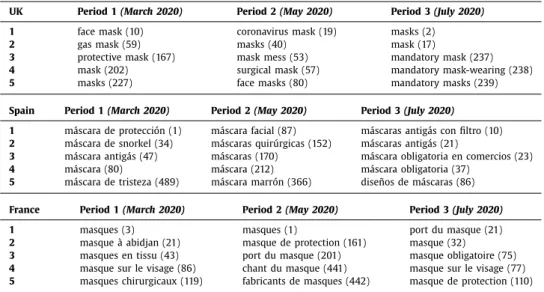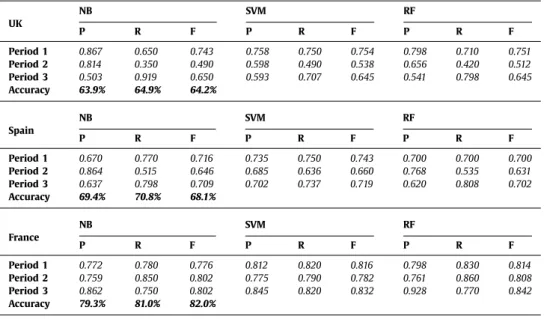HAL Id: hal-03125806
https://hal.inrae.fr/hal-03125806
Submitted on 29 Jan 2021
HAL is a multi-disciplinary open access
archive for the deposit and dissemination of
sci-entific research documents, whether they are
pub-lished or not. The documents may come from
teaching and research institutions in France or
abroad, or from public or private research centers.
L’archive ouverte pluridisciplinaire HAL, est
destinée au dépôt et à la diffusion de documents
scientifiques de niveau recherche, publiés ou non,
émanant des établissements d’enseignement et de
recherche français ou étrangers, des laboratoires
publics ou privés.
COVID-19 and Media datasets: Period- and
location-specific textual data mining
Mathieu Roche
To cite this version:
Mathieu Roche. COVID-19 and Media datasets: Period- and location-specific textual data mining.
Data in Brief, Elsevier, 2020, 33, pp.106356. �10.1016/j.dib.2020.106356�. �hal-03125806�
ContentslistsavailableatScienceDirect
Data
in
Brief
journalhomepage:www.elsevier.com/locate/dib
Data
Article
COVID-19
and
Media
datasets:
Period-
and
location-specific
textual
data
mining
Mathieu
Roche
CIRAD, UMR TETIS, F-34398 Montpellier, France
TETIS, Univ Montpellier, AgroParisTech, CIRAD, CNRS, INRAE, Montpellier, France
a
r
t
i
c
l
e
i
n
f
o
Article history:
Received 12 August 2020 Revised 10 September 2020 Accepted 16 September 2020 Available online 30 September 2020
Keywords: Corpus Text-mining NLP Terminology extraction Classification COVID-19
a
b
s
t
r
a
c
t
ThevocabularyusedinnewsonadiseasesuchasCOVID-19 changesaccordingtheperiod[4].Thisaspectisdiscussedon thebasisofMEDISYS-sourcedmediadatasetsviatwostudies. Thefirst focusesonterminologyextraction and thesecond onperiodpredictionaccordingtothe textualcontentusing machinelearningapproaches.
© 2020TheAuthor(s).PublishedbyElsevierInc. ThisisanopenaccessarticleundertheCCBYlicense (http://creativecommons.org/licenses/by/4.0/)
Specifications
Table
Subject area Health Informatics
More specific subject area Text-mining approaches for health and social analysis (COVID-19)
Type of data Text
How data was acquired Manual extraction from MEDISYS:
https://medisys.newsbrief.eu/medisys/homeedition/fr/home.html
Data format Raw: (1) Corpus for BioTex ( ∗.txt) [repositories: ∗_MOOD_Corpus_BIOTEX], (2)
Corpus for Weka ( ∗.arff) [repositories: ∗_MOOD_Corpus_WEKA]
Filtered: Terms extracted with BioTex from corpus (1) ( ∗.csv)
Parameters for data collection
Dedicated keywords, locations and languages for selecting data from MEDISYS. Specific parameters and algorithms are applied for NLP and data mining tools (ranking measures, classification algorithms, etc.).
E-mail address: mathieu.roche@cirad.fr
https://doi.org/10.1016/j.dib.2020.106356
2352-3409/© 2020 The Author(s). Published by Elsevier Inc. This is an open access article under the CC BY license ( http://creativecommons.org/licenses/by/4.0/ )
2 M. Roche / Data in Brief 33 (2020) 106356
( continued on next page ) Description of data
collection
These datasets contain a set of news articles in English, Spanish and French extracted from MEDISYS (i.e. advanced search) according dedicated criteria. A corpus (i.e. textual data) by location (UK, Spain, France) and period (March, May, July 2020) has been collected from MEDISYS. Corpora have an adapted format for BioTex ( ∗.txt) and Weka ( ∗.arff). Terms extracted ( ∗.csv) with the
BioTex system from these corpora are available. Data source location MEDISYS (open access)
Data accessibility Repository name: Dataverse (CIRAD)
Data identification number: https://doi.org/10.18167/DVN1/ZUA8MF
Value
of
the
Data
•
This
dataset
is
important
for
spatiotemporal
analysis
of
media
content
regarding
COVID-19.
The
methodology
is
generic
and
could
be
implemented
for
other
study
cases
based
on
MEDISYS
data.
•
This
data
could
be
used
by
computer
science
scientists
(NLP
and
data
mining
domains)
and
for
social
science
and
humanities
research.
•
The
formats
of
these
datasets
are
suitable
for
NLP
approaches
(e.g.
BioTex)
and
data-mining
tools
(e.g.
Weka).
•
Other
corpora
could
also
be
collected
with
the
method
outlined
in
this
data
paper.
The
code
(Perl)
enables
the
conversion
of
other
textual
data
from
MEDISYS
in
suitable
formats
for
NLP
and
data-mining
tools.
1.
Data
Description
These
datasets
contain
a
set
of
news
articles
in
English,
French
and
Spanish
extracted
from
MEDISYS
(i.e.
advanced
search)
according
the
following
criteria:
3-
Keywords
(at
least):
COVID-19,
ncov2019,
cov2019,
coronavirus
3-
Keywords
(all
words):
mask
(English),
máscara
(Spanish),
masque
(French)
3-
3
periods:
March
2020,
May
2020,
July
2020
3-
3
locations:
UK
(English),
Spain
(Spanish),
France
(French)
Location-specific
corpora
were
manually
collected
(copy/paste)
by
querying
MEDISYS
with
the
previous
parameters
(i.e.
primary
data
sources).
For
each
location,
100
snippets
by
period
(1st,
10th,
15
thand
20th
of
each
month)
were
built.
These
data
were
preprocessed
using
a
ded-icated
Perl
program
followed
by
text-mining
algorithms
(see
section
below)
in
order
to
produce
the
following
datasets
(i.e.
secondary
dataset
-
https://doi.org/10.18167/DVN1/ZUA8MF
):
3-
A
corpus
preprocessed
for
the
BioTex
tool
-
https://gitlab.irstea.fr/jacques.fize/biotex
_
python
(
∗.txt
1)
[
∼ 900
texts];
3-
The
same
corpus
preprocessed
for
the
Weka
tool
-
https://www.cs.waikato.ac.nz/ml/weka/
(
∗.arff
2);
3-
Terms
extracted
with
BioTex
according
spatiotemporal
criteria
(
∗.csv
3)
[
∼ 90
0
0
terms].
Other
corpora
can
be
collected
with
the
same
method.
The
code
(Perl)
required
to
prepro-cess
textual
data
for
terminology
extraction
(with
BioTex)
and
classification
(with
Weka)
tasks
is
available
on
Dataverse:
https://doi.org/10.18167/DVN1/ZUA8MF
.
1 Each article (line) is separated by a blank line. 2 https://www.cs.waikato.ac.nz/ ∼ml/weka/arff.html
3 Each line includes the rank, term and presence (i.e. value = 1) of the term in UMLS (Unified Medical Language Sys-
The
textual
data
acquisition
phase
is
done
manually
by
querying
MEDISYS.
The
other
tasks
described
in
this
paper
are
automatic
(i.e.
pre-processing,
terminology
extraction,
classification).
In
future
research,
we
plan
to
use
RSS
feeds
provided
by
MEDISYS
in
order
to
collect
data
auto-matically.
2.
Experimental
Design,
Materials
and
Methods
With
these
datasets,
two
experiments
were
conducted
per
location:
3-
Terminology
extraction
tasks
using
NLP
approaches
to
highlight
specific
terms
.
Terminol-ogy
extraction
is
based
on
the
BioTex
system
[2]
.
Several
measures
are
implemented
in
BioTex
for
term
ranking.
The
F-TFIDF-C
criterion
based
on
a
combination
of
TF-IDF
[3]
and
C-Value
[1]
were
used
for
these
datasets.
TF-IDF
highlights
discriminative
terms,
while
C-Value
favors
phrase
(i.e.
multiword
term)
extraction.
The
extraction
results
are
available
in
the
Dataverse
repository
associated
with
this
study
(BioTex
parameters
used:
F-TFIDF-C
measure,
number
of
syntactic
patterns:
10,
3
languages).
Table
1
presents
a
sample
of
these
results,
i.e.
terminology
selected
with
the
word
mask
from
UK_MOOD_Terms,
SP_MOOD_Terms
and
FR_MOOD_Terms
raw
data.
We
found
that
the
vocabulary
could
be
period-
and
location-specific,
but
similar
trends
were
also
noted
for
some
aspects
like
mandatory
mask-wearing
in
July
for
all
locations
(e.g.
mandatory
mask,
mandatory
mask-wearing,
máscara
obligatoria
en
comercios,
máscara
obligatoria,
masque
obligatoire
).
3-
Classification
tasks
using
machine
learning
approaches
for
period
prediction
.
Based
on
a
vector
space
model
representation
(i.e.
bag-of-words),
the
objective
is
to
predict
periods
using
machine
learning
approaches.
Note
that
each
month
represents
the
class
to
predict
with
supervised
learning
techniques
(i.e.
in
the
ARFF
files,
each
article
has
a
label
associated
with
the
month).
Table 1
Terms obtained with BioTex filtered with the word mask ( mask, máscara, masque ) and the associated rank for the 3 locations.
UK Period 1 (March 2020) Period 2 (May 2020) Period 3 (July 2020)
1 face mask (10) coronavirus mask (19) masks (2)
2 gas mask (59) masks (40) mask (17)
3 protective mask (167) mask mess (53) mandatory mask (237)
4 mask (202) surgical mask (57) mandatory mask-wearing (238)
5 masks (227) face masks (80) mandatory masks (239)
Spain Period 1 (March 2020) Period 2 (May 2020) Period 3 (July 2020) 1 máscara de protección (1) máscara facial (87) máscaras antigás con filtro (10) 2 máscara de snorkel (34) máscaras quirúrgicas (152) máscaras antigás (21)
3 máscara antigás (47) máscaras (170) máscara obligatoria en comercios (23)
4 máscara (80) máscara (212) máscara obligatoria (37)
5 máscara de tristeza (489) máscara marrón (366) diseños de máscaras (86) France Period 1 (March 2020) Period 2 (May 2020) Period 3 (July 2020)
1 masques (3) masques (1) port du masque (21)
2 masque à abidjan (21) masque de protection (161) masque (32)
3 masques en tissu (43) port du masque (201) masque obligatoire (75) 4 masque sur le visage (86) chant du masque (441) masque sur le visage (77) 5 masques chirurgicaux (119) fabricants de masques (442) masque de protection (110)
4 M. Roche / Data in Brief 33 (2020) 106356
Table 2
Classification scores (i.e. precision (P), recall (R) and F-measure (F)) using 10 cross-validations for period prediction at 3 locations (NB: Naïve Bayes, SVM: Support Vector Machine, RF: Random Forest).
UK NB SVM RF P R F P R F P R F Period 1 0.867 0.650 0.743 0.758 0.750 0.754 0.798 0.710 0.751 Period 2 0.814 0.350 0.490 0.598 0.490 0.538 0.656 0.420 0.512 Period 3 0.503 0.919 0.650 0.593 0.707 0.645 0.541 0.798 0.645 Accuracy 63.9% 64.9% 64.2% Spain NB SVM RF P R F P R F P R F Period 1 0.670 0.770 0.716 0.735 0.750 0.743 0.700 0.700 0.700 Period 2 0.864 0.515 0.646 0.685 0.636 0.660 0.768 0.535 0.631 Period 3 0.637 0.798 0.709 0.702 0.737 0.719 0.620 0.808 0.702 Accuracy 69.4% 70.8% 68.1% France NB SVM RF P R F P R F P R F Period 1 0.772 0.780 0.776 0.812 0.820 0.816 0.798 0.830 0.814 Period 2 0.759 0.850 0.802 0.775 0.790 0.782 0.761 0.860 0.808 Period 3 0.862 0.750 0.802 0.845 0.820 0.832 0.928 0.770 0.842 Accuracy 79.3% 81.0% 82.0%
Table
2
presents
the
results
obtained
with
3
supervised
algorithms
(i.e.
Support
Vector
Machine
(SMO
with
PolyKernel),
Random
Forest
(bagSizePercent
=
100,
maxDepth
=
0,
numIterations
=
100)
and
Naive
Bayes)
with
the
raw
data
UK_MOOD_Corpus_WEKA,
SP_MOOD_Corpus_WEKA
,
FR_MOOD_Corpus_WEKA
.
Other
Weka
algorithms
can
also
be
used
with
these
corpora.
Ethics
Statement
The
author
confirms
compliance
with
the
ethical
policies
of
the
journal,
as
noted
on
the
journal’s
author
guidelines
page.
No
ethical
approval
was
required
because
this
study
did
not
involve
any
experimental
protocol
on
humans
or
animals,
and
only
open
source
online
data
were
used.
This
work
is
based
on
a
sample
of
data
from
MEDISYS
(public
site)
that
is
an
open
access
system
available
for
all
users
4.
Declaration
of
Competing
Interest
The
author
declares
no
conflicts
of
interest.
Acknowledgements
This
work
was
partly
funded
by
the
H2020
‘Monitoring
outbreak
events
for
disease
surveil-lance
in
a
data
science
context’
(MOOD)
project
under
grant
agreement
No.
874850
(
https:
//mood
-
h2020.eu/
),
the
French
General
Directorate
for
Food
(DGAL),
the
French
Agricultural
Re-search
Centre
for
International
Development
(CIRAD)
and
the
SONGES
Project
(FEDER
and
Occ-itanie).
This
work
was
supported
by
the
French
National
Research
Agency
(ANR)
under
the
In-vestments
for
the
Future
Program
(ANR-16-CONV-0
0
04).
The
author
thanks
Jens
LINGE
(Joint
Research
Centre
(JRC)
-
European
Commission)
for
data
sharing.
Supplementary
Materials
Supplementary
material
associated
with
this
article
can
be
found,
in
the
online
version,
at
doi:
10.1016/j.dib.2020.106356
.
References
[1] K.T. Frantzi , S. Ananiadou , H. Mima , Automatic recognition of multi-word terms: the C-value/NC-value method, Int. J. on Digital Libraries 3 (2) (20 0 0) 115–130 .
[2] J.A. Lossio-Ventura , C. Jonquet , M. Roche , M. Teisseire , Biomedical term extraction: overview and a new methodology, Inform. Retrieval J. 19 (1) (2016) 59–99 .
[3] G. Salton , M.J. McGill , Introduction to Modern Information Retrieval , McGraw-Hill, 1983 .
[4] S. Valentin , A. Mercier , R. Lancelot , M. Roche , E Arsevska , Monitoring online media reports for early detection of unknown diseases: Insight from a retrospective study of COVID-19 emergence, Trans. Emerging Dis. (2020) .

